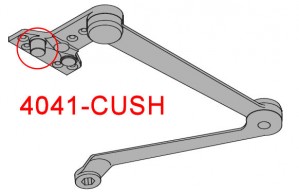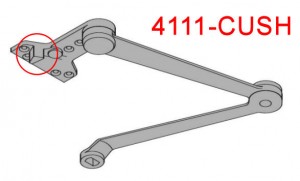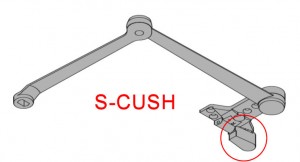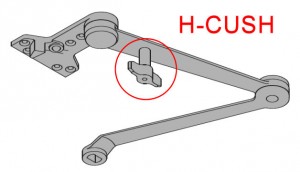A few weeks ago someone asked me this question and I answered him directly rather than posting about it on the blog, but then yesterday I saw someone arrive at the site searching for the very same information. So, in case you too have been wondering what “CUSH” means in relation to door hardware, here you go…
CUSH is short for Cush-N-Stop, and it’s used in conjunction with LCN closers. You may also see it abbreviated as “CNS.” Other closer manufacturers offer the same feature but use different terminology to describe it. A CUSH arm has a door stop built into it, so when the arm reaches a certain point in the opening cycle of the door, the arm hits the stop on the shoe and stops the door.
There are several variations…the application-specific 4111-CUSH has the stop cast into the shoe. The universal 4041-CUSH has a stop that attaches in one of two positions on the shoe so it can be used for either hand. The Spring-CUSH or S-CUSH feature has a spring-loaded stop, to cushion the stop-effect. CUSH arms are also available with the hold-open feature, which would incorporate a t-handle to engage/disengage the hold-open.
With LCN products, the built-in stop is available for parallel-arm mounted closers only, because of the physics of the arm movement. It’s very handy for doors where a wall- or floor-stop can’t be used, but in abusive situations I recommend using a closer with a separate overhead stop. There are special templates available to help coordinate the installation of both products on the same real estate.
Here are some arm diagrams to help illustrate the various types:
You need to login or register to bookmark/favorite this content.










Hello Lori, another great post to start my morning, another post on DOOR CLOSERS!!!
I’m most familiar with the 4111-cush and H-cush (used on 4010 series closers)used to see those arms all over the technical school I went to back in 2002.
these types of arms are also commonly known as detent HEDA, slight restriction (i think you forgot to mention) these on many schools are BANNED from use on fire doors and all exterior doors because of trespassers and fire code violations. only good thing, before they were banned they were really good at providing cross-ventilation in the halls.
if any high schooler/middle schooler is reading this, your classroom door closer’s HEDA arm IS NOT a monkey bar. CUSH does NOT stand for Chin Up School Hardware (heheh, HAD to use alittle closer humor there….)so please, RESIST the urge to jump up and grab the arm and do chin up’s….its up there for a purpose, and that IS NOT for arm exercise when not in gym class!
a closer over time that alot of kids doing pull-ups on the arms, can cause pinion inside the closer to be “side loading” means the closer’s pinion is NOT completely vertical and meshing with rack teeth properly causing premature o-ring wear and risk of snapping a tooth off inside the closer causing the closer to NOT even close the door (closer appears to be in a coma which is costly to repair) if closer is under 10 years old, closer can be sent back to factory for rebuild) this is 2 main reasons why LCN made the 4040XP.
yes, other makers of closers use arms SIMILAR to HEDA and the different variations of CUSH arms. Norton for instance, they call theirs just a standard EDA type of arm as CLP (closerPlus arm)
another tip to consider when you want to close the door that uses a detent HEDA arm,
1. either pull door a little to close it
2. TWIST the T shaped handle on forearm section, in high school that went to that had these installed on the cafeteria doors, I once seen a recruiter from armed forces fight the hold open to get it to release……… this guy he thought you PULL the handle, that only got him alittle embarrassment and me laughing, and him a bruised index and middle finger so yea, you TURN IT NOT PULL IT!!
ok I think you may know by now i have payed alittle TOO MUCH attention to the LCN door controls e-learning course….hehehehe
a suggestion to LCN….why not dip that T-handle in that rubberized material used on handles of tools?? probably be alittle more comfortable and not as HOT in the summertime if arm has been open in the sun all day.
another term I have heard for these arms, (said by complete hardware novices……”dental drill style arms”(because of how they resemble the dental belt driven drill from 1930’s) “those arms that look like the closer has gout” arms because of the oversized joints at the “elbow” and “wrist” joints. other term used by school children, “classroom monkey bars”
everything I wanted to know about cush and was afraid to ask, thanks, now something else to inspect for.
Jess,
Be careful with your terminology. The HEDA arm is actually a friction hold open, not the same as an HCUSH or S HCUSH. You can always tell a version of the hold open CUSH by the “T” handle on the arm, used to engage tor disengage the hold open.
Can you please tell me what type of parrallel arm door closer we provide for a store room door of:
1-3/4” thick, RHR, 45 min lebel
Splayed stop frame, 5-3/4” frame depth, 1” Soffit
I proposed LCN P4030 CUSH with 4030-30 Cush Shoe Support, is this right? Can we use P4030-Rw/PA without CUSH Arm?
You really are the best and the smartest. Today, again, I struggled with “What does CUSH mean?”
And there you were right there
What does the number 3049 signify in CLOSER 4110-3049SCNS?
Hi Nick –
The 3049 tells me that the model number is for the arm only. It’s a spring-cush arm for a 4110 series parallel arm closer, but it’s just the arm. If you want the whole closer you would order 4111-SCNS.
– Lori
Oh, is it so? Thanks for the information.
Post from almost 10 years ago but still helpful today. Thanks for putting this out there and helping educate us all!
Hi Darin –
I’m glad you found it and that it was helpful! 🙂
I will have to think of something BIG to celebrate iDigHardware’s 10th anniversary!
– Lori
This is going to sound really silly but a coworker disabled our ability to push the door open. Normally I would just turn the latch and enable it again but he somehow disengaged the entire mechanism. He’s on vacation for a week now. Any advice on how to get it back to working order?
Hi Amelia –
Any chance you could send me a photo or video of what you’ve got? lori.greene@allegion.com
– Lori